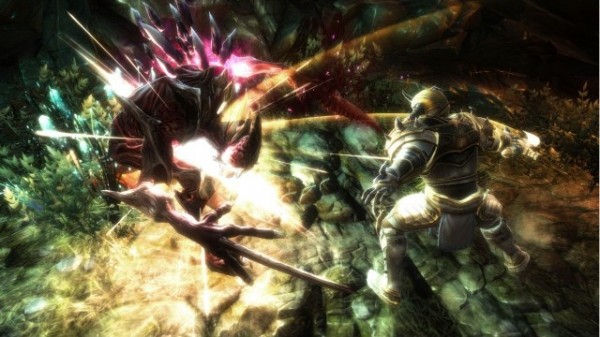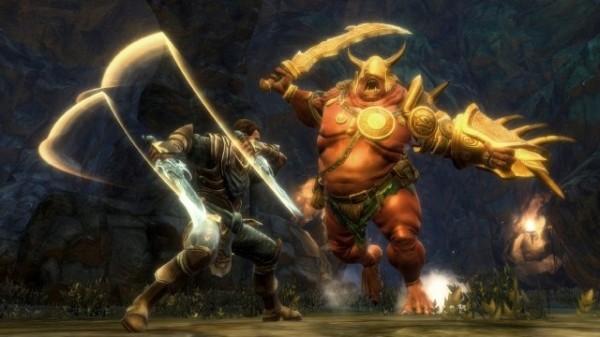Every mortal of Amalur is born inside the weave of fate, doomed to walk along an unchangeable path and endure predetermined events – except for you, the hero. How exactly you fell is unknown, nor is it important, because fate can now be twisted to your liking. Also unimportant, it feels, is the majority of your journey, riddled with such vapid content that it becomes, at times, inconsequential.
My first venture away from the main narrative arc is a good example. A woman is stabbed and poisoned in the middle of town, and no one, save for the hero with the power of choice, is capable of attaining the antidote. To do this, I stroll up a nearby hill and speak to a Winter Fae, a member of Amalur’s magical race. She won’t give me the cure, though, at least not until I run a few errands. Rather than go on a scavenger hunt for a rather simple item, I ask an alchemist for a potion, but she, too, sends me on looking for something else. In my frustration, I abandon the quest and the woman, feeling only slight regret. Many of the secondary and tertiary quests lead to this inevitable cycle of meaningless fetch demands, so I give up attempting them.
Back on the main narrative path, my character – a warrior, heavily clad with clanky steel armor and equipped with a deadly greatsword – finds more impetus to defeat evil, save Amalur, et al. The end-goal is alluring, and incentives like leveling and customization do push the game along, but Amalur is still hard to get lost in. Generic heaps of lore make the story confusing, and, in turn, it’s easy to lose track of space, place, and purpose.
Chats with the villagers range from uninteresting to flat-out boring, making it seem as if the hero is the only sentient being in the kingdom. Non-player characters talk about no-good bandits I should have killed already or about the looming Tuathan invasion. That’s all anyone talks about! Conversations weren’t written to convince the player of the world’s authenticity. I’m commanded to progress, rather than led by incentive.
Equally unconvincing are the environments of Amalur, which will look familiar to anyone who has played a western role-playing game in the past ten years. Character models, items, and everything else that make up the tangible environment aren’t bad, just generic in every sense.
Fluid and precise, combat is easily the most enticing reason to play the game. No matter the race, players can specialize in a number of combat styles; stealth, ranged, magic, brute strength, or a mix of each. All are satisfying styles of play. I favor melee combat, but magic spells also form effective attack augments. If all else fails, the player’s fate-twisting abilities allow for Reckoning mode, a slow-motion, XP-boosting mega-attack. The vast amount of resources made available in combat make for an engaging action experience, and I can’t get enough of it.
Kingdoms of Amalur: Reckoning adheres to its fate-defying theme by allowing change in play styles, though one archetype is usually settled on. Not enjoying life as a clanky, battle-hardened knight? Well, drop the armor, pick up a bow, and be a sneaky, shadow-lurking thief. Further, certain milestones in rank allow the player to change character attributes altogether. These options make dabbling in the many play styles easy and rewarding.
Amalur is an ambitious title, one that will resonate with fans of the western role-playing genre. Unfortunately, the ambition falls short of the finished product. Its combat is rewarding and fun, and character customization is as deep as it gets, but the content inside Amalur – generic environments, stale characters, tiring side-quests – often leave me feeling indignant or discouraged. Such a forgettable world doesn’t deserve your attention, let alone the vast amount of time needed to fully explore or understand it.




















